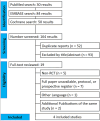Donor's therapeutic hypothermia vs. normothermia in kidney transplantation: a meta-analysis of randomized controlled trials
- PMID: 40248161
- PMCID: PMC12003384
- DOI: 10.3389/frtra.2025.1564460
Donor's therapeutic hypothermia vs. normothermia in kidney transplantation: a meta-analysis of randomized controlled trials
Abstract
Introduction: The shortage of organs remains one of the most challenging global problems nowadays. Donor's therapeutic hypothermia was suggested to decrease kidney delayed graft function (DGF) when compared to normothermia in previous trials, but the role of such intervention is still controversial. To assess this, we performed a systematic review and meta-analysis of randomized clinical trials (RCTs) investigating the benefits of donor hypothermia in DGF rate and Graft Failure.
Methods: MEDLINE, Embase, and Cochrane databases were systematically searched for studies of deceased organ donors who underwent hypothermia or normothermia prior to kidney transplantation. Statistical analysis was performed using R Studio version 3.6. Heterogeneity was assessed using I 2 statistics and a Baujat Plot.
Results: Four different RCTs were analyzed, including more than 3,000 recipients. Donor hypothermia was associated with a lower, but not statistically significant, rate of DGF (RR 0.87; 95% CI 0.71-1.08; P = .21) and graft failure (RR 0.70; 95% CI 0.45-1.10; P = .12). When analyzing only expanded criteria donors, a significantly lower rate of DGF was observed in the hypothermia-treated group (RR 0.65; 95% CI 0.47-0.89; P = .008). Sensitivity analysis identified one study as an outlier, probably due to protocol deviation. When excluded from the analysis, a significant reduction in DGF rate was observed among the hypothermia-treated group (RR 0.80; 95% CI 0.67-0.94; P = .007).
Conclusion: Our meta-analysis could not find a statistical difference between donor therapeutic hypothermia and normothermia in preventing DGF or Graft Failure. However, these results may be influenced by outliers and the limitations of the included studies. Further research is needed to clarify the role of donor hypothermia in kidney transplantation. If proven beneficial, it could be a promising alternative to sites where preservation techniques are limited, such as low-income countries.
Systematic review registration: https://www.crd.york.ac.uk/PROSPERO/view/CRD42024581665, PROSPERO (CRD42024581665).
Keywords: delayed graft function; graft failure; graft survival; hypothermia; kidney transplantation.
© 2025 Marcolin Miranda, De Lima, Dias Miranda, Margraf and Riella.
Conflict of interest statement
The authors declare that the research was conducted in the absence of any commercial or financial relationships that could be construed as a potential conflict of interest.
Figures





Similar articles
-
Machine perfusion preservation versus static cold storage for deceased donor kidney transplantation.Cochrane Database Syst Rev. 2019 Mar 15;3(3):CD011671. doi: 10.1002/14651858.CD011671.pub2. Cochrane Database Syst Rev. 2019. Update in: Cochrane Database Syst Rev. 2024 Jul 9;7:CD011671. doi: 10.1002/14651858.CD011671.pub3. PMID: 30875082 Free PMC article. Updated.
-
Hypothermia for expanded criteria organ donors in kidney transplantation in France (HYPOREME): a multicentre, randomised controlled trial.Lancet Respir Med. 2024 Sep;12(9):693-702. doi: 10.1016/S2213-2600(24)00117-6. Epub 2024 Jun 11. Lancet Respir Med. 2024. PMID: 38876137 Clinical Trial.
-
Therapeutic Hypothermia in Low-Risk Nonpumped Brain-Dead Kidney Donors: A Randomized Clinical Trial.JAMA Netw Open. 2024 Feb 5;7(2):e2353785. doi: 10.1001/jamanetworkopen.2023.53785. JAMA Netw Open. 2024. PMID: 38416500 Free PMC article. Clinical Trial.
-
Therapeutic Hypothermia in Deceased Organ Donors and Kidney-Graft Function.N Engl J Med. 2015 Jul 30;373(5):405-14. doi: 10.1056/NEJMoa1501969. N Engl J Med. 2015. PMID: 26222557 Clinical Trial.
-
Hypothermic Machine Perfusion Versus Static Cold Storage in Deceased Donor Kidney Transplantation: A Systematic Review and Meta-Analysis of Randomized Controlled Trials.Artif Organs. 2019 May;43(5):478-489. doi: 10.1111/aor.13364. Epub 2018 Nov 9. Artif Organs. 2019. PMID: 30282122
Cited by
-
Current Perspectives on Rehabilitation Following Return of Spontaneous Circulation After Sudden Cardiac Arrest: A Narrative Review.Healthcare (Basel). 2025 Jul 30;13(15):1865. doi: 10.3390/healthcare13151865. Healthcare (Basel). 2025. PMID: 40805898 Free PMC article. Review.
References
-
- Lentine KL, Smith JM, Miller JM, Bradbrook K, Larkin L, Weiss S, et al. OPTN/SRTR 2021 annual data report: kidney organ procurement and transplantation network, United Network for Organ Sharing (2023).
Publication types
LinkOut - more resources
Full Text Sources

